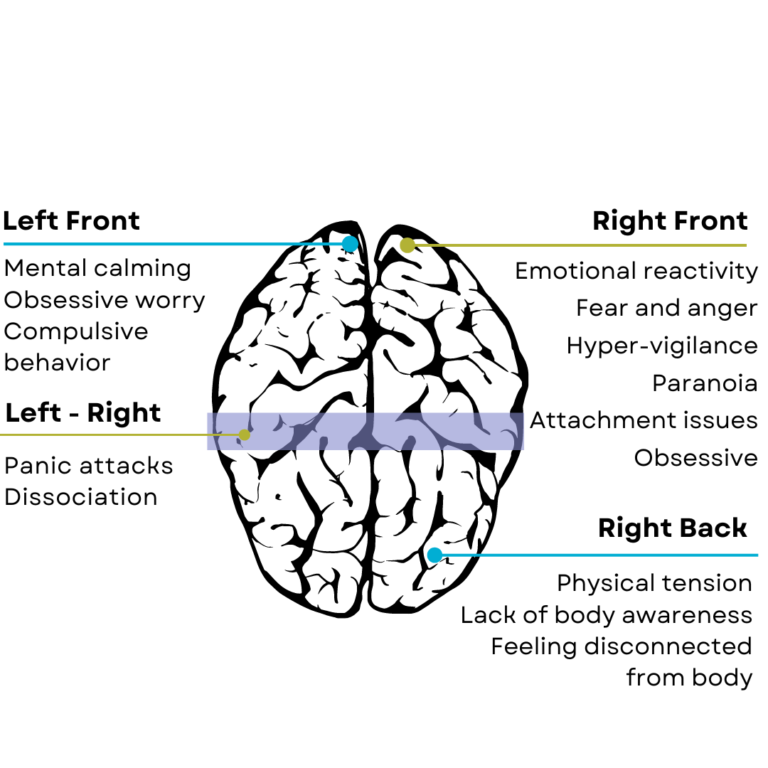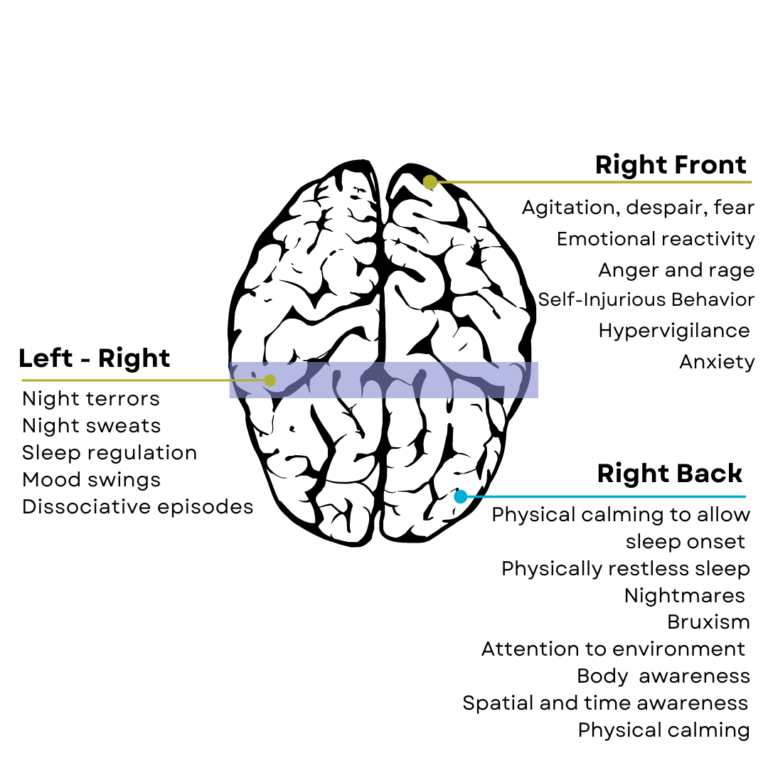Anxiety, PTSD, OCD, & Panic Disorders
Neurofeedback has emerged as a promising therapeutic approach in addressing a spectrum of mental health conditions, including Anxiety, Post-Traumatic Stress Disorder (PTSD), Obsessive-Compulsive Disorder (OCD), and Panic Disorders. These disorders share commonalities in terms of aberrant neural patterns and dysregulation, making neurofeedback a versatile and holistic intervention.
In Anxiety disorders, individuals often exhibit heightened activity in brain regions associated with fear and stress responses. Neurofeedback allows individuals to gain real-time insights into their brain activity and learn to self-regulate, potentially reducing excessive arousal and anxiety. Similarly, PTSD involves maladaptive neural responses linked to traumatic experiences. Neurofeedback aids in retraining these responses, promoting emotional regulation, and reducing the intensity of PTSD symptoms.
OCD is characterized by repetitive thoughts and compulsive behaviors driven by underlying neural patterns. Neurofeedback offers a means to target and modify these patterns, providing individuals with tools to interrupt the cycles of obsessive thoughts and compulsive actions. Panic disorders involve sudden and intense surges of fear, often accompanied by physical symptoms. Neurofeedback may assist in regulating the neural pathways associated with these intense emotional responses, mitigating the frequency and severity of panic attacks.
Unlike medication, which often addresses symptoms but may have side effects or limited long-term efficacy, neurofeedback aims to address the underlying neural dysregulation contributing to these disorders. By promoting self-regulation and neuroplasticity, neurofeedback fosters lasting changes in brain function. Moreover, it offers a non-invasive and personalized approach, avoiding potential medication-related side effects.
The effectiveness of neurofeedback in these conditions is supported by research demonstrating improvements in symptoms and changes in neural activity. Through personalized training protocols targeting specific brain regions and frequencies, neurofeedback empowers individuals to participate in their healing process actively. While medication may provide symptomatic relief, neurofeedback offers a more comprehensive and enduring solution by addressing the root causes of these interconnected disorders.
Treatment Sites With Neurofeedback


Studies
Gadea, M., Aliño, M., Hidalgo, V., Espert, R., & Salvador, A. (2020). Effects of a single session of SMR neurofeedback training on anxiety and cortisol levels. Neurophysiologie clinique = Clinical neurophysiology, 50(3), 167–173. Objectives: To explore the potential calming effects of EEG neurofeedback training as a therapeutic tool in psychiatric practice, we investigated the efficacy of a single session of ↑sensorimotor (SMR)/↓theta neurofeedback training for mood enhancement in 32 healthy men, considering trainability, independence, and interpretability of results. Methods: Employing a pre-post design, we assessed mood using psychometric measures (Profile of Mood State, POMS, and State-Trait Anxiety Inventory, STAI), biological measures (salivary cortisol levels), and neurophysiological measures (EEG frequency band power analysis). A control group receiving sham neurofeedback was included. Results: Anxiety levels significantly decreased after real neurofeedback and increased after sham neurofeedback (P<0.01, size effect 0.9 for group comparison). Cortisol levels decreased in both groups, with more pronounced effects after real neurofeedback (P<0.04; size effect 0.7). The real neurofeedback group significantly enhanced their SMR band (P<0.004; size effect 0.88) without changes in the theta band. The sham neurofeedback group showed no EEG changes. Conclusions: Anxiety improvement was greater in the experimental group than in the sham group, confirmed by both subjective (psychometric) and objective (biological) measures. Real neurofeedback was associated with this improvement.
Gapen, M., van der Kolk, B. A., Hamlin, E., Hirshberg, L., Suvak, M., & Spinazzola, J. (2016). A Pilot Study of Neurofeedback for Chronic PTSD. Applied psychophysiology and biofeedback, 41(3), 251–261. EEG Biofeedback, also known as neurofeedback, has been a clinical intervention for over 30 years but has had a limited impact on clinical care, partly due to challenges in designing real-world research to measure clinical change. This study serves as a “proof-of-concept” pilot for neurofeedback in individuals with treatment-resistant PTSD. Participants underwent 40 neurofeedback training sessions twice a week with randomly assigned sensor placements. Neurofeedback significantly reduced PTSD symptoms (from an average Davidson Trauma Scale score of 69.14 at baseline to 49.26 at termination) and preceded improvements in affect regulation (Inventory of Altered Self-Capacities-Affect Dysregulation scores averaged 23.63 at baseline to 17.20 at termination).
Hammond, D. C. (2003). QEEG-guided neurofeedback in the treatment of obsessive compulsive disorder. Journal of Neurotherapy, 7(2), 25-52. A quantitative EEG assessment was conducted on two consecutive OCD patients seeking treatment. These assessments guided the selection of protocols for subsequent neurofeedback training. Results: Following treatment, scores on the Yale-Brown Obsessive-Compulsive Scale and the Padua Inventory showed normalization. In one patient, an MMPI administered pre-post revealed significant improvements not only in OCD symptoms but also in depression, anxiety, somatic symptoms, and a shift from introversion to extroversion. Discussion: Follow-ups conducted 15 and 13 months after treatment completion showed both patients maintaining improvements in OCD symptoms, as measured by the Padua Inventory and validated through family contacts. Given the modest efficacy of pharmacologic treatment and the aversive nature of exposure-based behavior therapy for OCD, neurofeedback presents itself as a promising and more tolerable treatment modality.
Hammond, D. C. (2005). Neurofeedback with anxiety and affective disorders. Child & Adolescent Psychiatric Clinics of North America, 14(1), 105-123. A comprehensive review of neurophysiological research highlights functional brain abnormalities linked to depression, anxiety, and obsessive-compulsive disorder. Recent findings suggest that pharmacologic treatments may not be as effective as previously thought. A more contemporary neuroscience technology, electroencephalographic (EEG) biofeedback or neurofeedback, emerges as a promising approach for retraining abnormal brain wave patterns. Neurofeedback has shown minimal side effects and is less invasive compared to other methods addressing biological brain disorders. The literature is examined for the use of neurofeedback in anxiety disorders, including post-traumatic stress disorder and obsessive-compulsive disorder, as well as in depression, supported by case examples.
Hardt, J. V., & Kamiya, J. (1978). Anxiety change through electroencephalographic alpha feedback seen only in high-anxiety subjects. Science, 201, 79-81. Participants, categorized as either high or low in trait anxiety, utilized alpha feedback to modulate their electroencephalographic alpha activity—increasing and decreasing it. The observed alpha changes were strongly associated with alterations in anxiety levels, specifically in individuals with high-trait anxiety. This group’s anxiety decreased proportionally to alpha increases and increased proportionally to alpha suppression. Notably, subjects with low trait anxiety demonstrated superior performance in both enhancement and suppression training, although their alpha changes did not correlate with anxiety fluctuations. In both high and low trait-anxiety groups, changes in anxiety were generally unrelated to resting levels or alterations in frontalis electromyograms and respiration rate. These findings suggest that engaging in long-term alpha feedback training, spanning at least 5 hours, may hold therapeutic potential for managing anxiety.
Below you will find a PDF containing the studies provided above more.